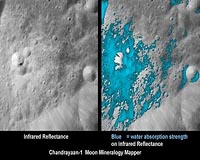 |
Sydney, Australia (SPX) Dec 03, 2009 Much attention has been focused on plans by various nations to return astronauts to the Moon. At the moment, it doesn't seem that anyone will be landing there for at least another decade. America is revising its original plans for the Orion program, which calls for a return to lunar orbital missions and landings. Some alternatives would see astronauts orbiting the Moon without landing, and also visiting asteroids. There's one mission plan that's been discussed a lot in the past, but doesn't seem too popular right now. Circumlunar missions are a way of moving quickly beyond Earth orbit and reaching a target in space, without as much of the complexity of a landing or even entering lunar orbit. Put simply, a circumlunar mission would send a spacecraft flying to the Moon, where it would pass around the Moon's far side, using the Moon's gravity to slingshot it back to Earth. A mission like this takes roughly six days to accomplish. In the 1960s, the Soviet Union introduced the Zond program, which was the world's first attempt at a manned circumlunar mission. Zond was a modified version of the Soyuz spacecraft, used to launch cosmonauts to Earth orbit. It would be launched to the Moon atop a Proton rocket, more powerful than the booster normally used to launch Soyuz. Zond test missions were flown to the Moon and back with animals on board, but the missions were not entirely successful. The program was cancelled as America's Apollo program gained ground by sending astronauts to orbit the Moon, without a single cosmonaut flying a mission. In 1970, the first manned circumlunar mission was flown, although the crew originally had no plans to make such a trip! Apollo 13 was intended to make America's third manned lunar landing. Halfway to the Moon, the spacecraft experienced an explosion that crippled the Service Module and placed the survival of the astronauts in jeopardy. The crew was rescued by flying a circumlunar trajectory that used the Moon's gravity to help them return to Earth. Today, circumlunar missions with Soyuz spacecraft have been proposed by at least one space tourism group. It is unclear when, or if, they will fly. Circumlunar missions could be too expensive and complex for space tourism at the moment. But this shouldn't stop government space programs and aerospace companies from drawing plans. A circumlunar mission could be a partial step towards a lunar orbital mission or a flight into deeper space. As the rescue of Apollo 13 demonstrated, the mission architecture has advantages of safety that aren't found in lunar orbital missions. This could take some of the risks out of testing new hardware in deep space. Circumlunar flight can be more than just a test run. It can also be scientifically useful. The crew of Apollo 13 still managed to take useful photography of the lunar surface as they flew past, despite their circumstances. A circumlunar mission presents the opportunities for observing the Moon, the Earth, and exploring the properties of deep space itself. Dr Morris Jones is the author of The New Moon Race, now available from Rosenberg Publishing (www.rosenbergpub.com.au). Share This Article With Planet Earth
Related Links the missing link Mars News and Information at MarsDaily.com Lunar Dreams and more
 Lunar Water Probably Came From Comets
Lunar Water Probably Came From CometsHouston TX (PTI) Nov 27, 2009 In a discovery that may solve the mystery behind the source of moon's water, an evidence from NASA's LCROSS mission suggested that much of it was delivered by comets that slammed into the Earth's satellite billions of years ago. Previous missions had also found hints of lunar water but its source was never clear. One idea is that it forms when hydrogen atoms from the solar wind latch onto ... read more |
|
| The content herein, unless otherwise known to be public domain, are Copyright 1995-2009 - SpaceDaily. AFP and UPI Wire Stories are copyright Agence France-Presse and United Press International. ESA Portal Reports are copyright European Space Agency. All NASA sourced material is public domain. Additional copyrights may apply in whole or part to other bona fide parties. Advertising does not imply endorsement,agreement or approval of any opinions, statements or information provided by SpaceDaily on any Web page published or hosted by SpaceDaily. Privacy Statement |